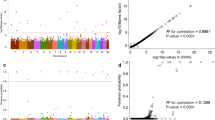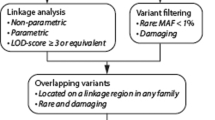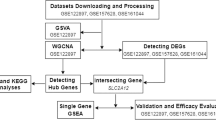Abstract
We previously performed a genome-wide linkage study of intracranial aneurysm (IA) and found positive evidence of linkage at chromosomes 5q22–31, 7q11, and 14q22. In the present study, we focus on 5q31, where three candidate genes, fibroblast growth factor 1 (FGF1), fibrillin 2 (FBN2), and lysyl oxidase gene (LOX) lie, and evaluate associations with IA. Genomic DNAs were obtained from 172 IA patients and 192 controls. Association analysis was performed with ten, five, and four single-nucleotide polymorphisms (SNPs) identified in FGF1, FBN2, and LOX, respectively. A difference in allelic frequency was observed for only the SNP at intron 4 in FGF1 (χ2=4.44, df=1, P=0.035). Although a haplotype association was observed with the combination of ten SNPs in FGF1 (χ2=16.04, df=1, P=0.00006), significant haplotype associations were not observed when haplotypes were constructed with the three, two, and four SNPs in FGF1 according to the linkage disequilibrium structure. No associations of FBN2 and LOX with IA were detected in the present study.
Similar content being viewed by others
Log in or create a free account to read this content
Gain free access to this article, as well as selected content from this journal and more on nature.com
or
References
ADHR Consortium (2000) Autosomal dominant hypophosphataemic rickets is associated with mutations in FGF23. Nat Genet 26:345–348
Baird A, Esch F, Mormede P, Ueno N, Ling N, Bohlen P, Ying SY, Wehrenberg WB, Guillemin R (1986) Molecular characterization of fibroblast growth factor: distribution and biological activities in various tissues. Recent Prog Horm Res 42:143–205
Basilico C, Moscatelli D (1992) The FGF family of growth factors and oncogenes. Adv Cancer Res 59:115–165
Burgess WH, Maciag T (1989) The heparin-binding (fibroblast) growth factor family of proteins. Annu Rev Biochem 58:575–606
Fogelholm R, Hernesniemi J, Vapalahti M (1993) Impact of early surgery on outcome after aneurysmal subarachnoid hemorrhage. A population-based study. Stroke 24:1649–1654
Gospodarowicz D, Neufeld G, Schweigerer L (1986) Molecular and biological characterization of fibroblast growth factor, an angiogenic factor which also controls the proliferation and differentiation of mesoderm and neuroectoderm derived cell. Cell Differ 19:1–17
Hill WG, Robertson A (1968) Linkage disequilibrium in finite populations. Theor Appl Genet 38:226–231
Inagawa T, Tokuda Y, Ohbayashi N, Takaya M, Moritake K (1995) Study of aneurysmal subarachnoid hemorrhage in Izumo City, Japan. Stroke 26:761–766
Ingall TJ, Whisnant JP, Wiebers DO, O'Fallon WM (1989) Has there been a decline in subarachnoid hemorrhage mortality? Stroke 20:718–724
Kagan HM, Trackman PC (1991) Properties and function of lysyl oxidase. Am J Respir Cell Mol Biol 5:206–210
Kagan HM, Vaccaro CA, Bronson RE, Tang SS, Brody JS (1986) Ultrastructural immunolocalization of lysyl oxidase in vascular connective tissue. J Cell Biol 103:1121–1128
Keramatipour M, McConnell RS, Kirkpatrick P, Tebbs S, Furlong RA, Rubinsztein DC (2000) The ACE I allele is associated with increased risk for ruptured intracranial aneurysms. J Med Genet 37:498–500
Kielty CM, Shuttleworth CA (1995) Fibrillin-containing microfibrils: structure and function in health and disease. Int J Biochem Cell Biol 27:747–760
Klagsbrun M, D'Amore PA (1991) Regulators of angiogenesis. Annu Rev Physiol 53:217–239
Krex D, Ziegler A, Schackert HK, Schackert G (2001) Lack of association between endoglin intron 7 insertion polymorphism and intracranial aneurysms in a white population: evidence of racial/ethnicdifferences. Stroke 32:2689–2694
Lewontin RC (1964) The interaction of selection and linkage. I. General considerations; heterotic models. Genetics 49:49–67
Myers RL, Payson RA, Chotani MA, Deaven LL, Chiu IM (1993) Gene structure and differential expression of acidic fibroblast growth factor mRNA: identification and distribution of four different transcripts. Oncogene 8:341–349
Nabel EG, Yang ZY, Plautz G, Forough R, Zhan X, Haudenschild CC, Maciag T, Nabel GJ (1993) Recombinant fibroblast growth factor-1 promotes intimal hyperplasia and angiogenesis in arteries in vivo. Nature 362:844–846
Naski MC, Ornitz DM (1998) FGF signaling in skeletal development. Front Biosci 3:D781–D794
Onda H, Kasuya H, Yoneyama T, Takakura K, Hori T, Takeda J, Nakajima T, Inoue I (2001) Genomewide-linkage and haplotype-association studies map intracranial aneurysm to chromosome 7q11. Am J Hum Genet 69:804–819
Onda H, Kasuya H, Yoneyama T, Hori T, Nakajima T, Inoue I (2003) Endoglin is not a major susceptibility gene to intracranial aneurysms among Japanese. Stroke (in press)
Robinson PN, Godfrey M (2000) The molecular genetics of Marfan syndrome and related microfibrillopathies. J Med Genet 37:9–25
Ronkainen A, Hernesniemi J, Puranen M, Niemitukia L, Vanninen R, Ryynanen M, Kuivaniemi H, Tromp G (1997) Familial intracranial aneurysms. Lancet 349:380–384
Schievink WI, Schaid DJ, Michels VV, Piepgras DG (1995) Familial aneurysmal subarachnoid hemorrhage: a community-based study. J Neurosurg 83:426–429
Skirgaudas M, Awad IA, Kim J, Rothbart D, Criscuolo G (1996) Expression of angiogenesis factors and selected vascular wall matrix proteins in intracranial saccular aneurysms. Neurosurgery 39:537–547
Takenaka K, Sakai H, Yamakawa H, Yoshimura S, Kumagai M, Yamakawa H, Nakashima S, Nozawa Y, Sakai N (1999) Polymorphism of the endoglin gene in patients with intracranial saccular aneurysms. J Neurosurg 90:935–938
Tsipouras P, Del Mastro R, Sarfarazi M, Lee B, Vitale E, Child AH, Godfrey M, Devereux RB, Hewett D, Steinmann B, et al (1992) Genetic linkage of the Marfan syndrome, ectopia lentis, and congenital contractural arachnodactyly to the fibrillin genes on chromosomes 15 and 5. N Engl J Med 326:905–909
Acknowledgements
This work was supported in part by a Research for the Future Program Grant of the Japan Society for the Promotion of Science (to I. Inoue), Ministry of Public Health and Welfare Research on Human Genome, Tissue Engineering Food Biotechnology (to I. Inoue), a Grant-in-aid for Scientific Research (C) from the Japanese Ministry of Education, Science, Sports and Culture (to H. Kasuya), and Research Found of Mitsukoshi Health and Welfare Foundation 2002 (to H. Onda). We thank Yuka Terada for technical assistance.
Author information
Authors and Affiliations
Corresponding author
Rights and permissions
About this article
Cite this article
Yoneyama, T., Kasuya, H., Onda, H. et al. Association of positional and functional candidate genes FGF1, FBN2, and LOX on 5q31 with intracranial aneurysm. J Hum Genet 48, 309–314 (2003). https://doi.org/10.1007/s10038-003-0030-6
Received:
Accepted:
Published:
Issue date:
DOI: https://doi.org/10.1007/s10038-003-0030-6
Keywords
This article is cited by
-
Lack of association of Lysyl oxidase (LOX) gene polymorphisms with intracranial aneurysm in a south Indian population
Molecular Biology Reports (2013)
-
Fine mapping of a linkage peak with integration of lipid traits identifies novel coronary artery disease genes on chromosome 5
BMC Genetics (2012)
-
Systematic screening of lysyl oxidase-like (LOXL) family genes demonstrates that LOXL2 is a susceptibility gene to intracranial aneurysms
Human Genetics (2007)
-
The genetics of intracranial aneurysms
Journal of Human Genetics (2006)
-
The Familial Intracranial Aneurysm (FIA) study protocol
BMC Medical Genetics (2005)



